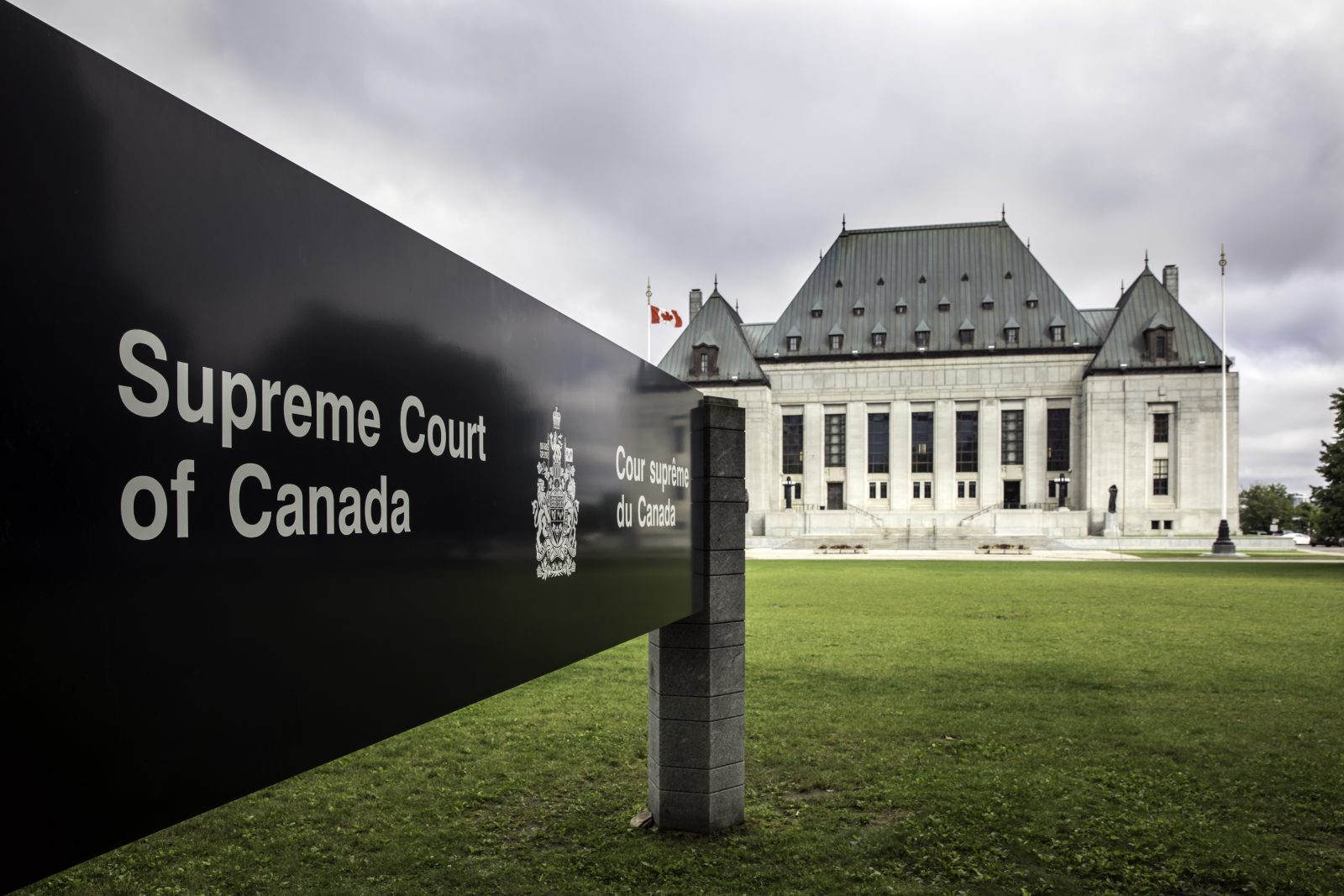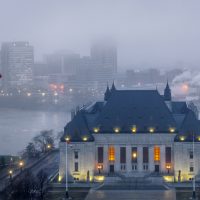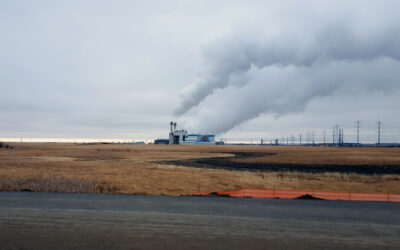In its recent landmark ruling, the Supreme Court of Canada (SCC) confirmed that the jurisdiction to regulate greenhouse gas (GHG) emissions lies with the federal government. But while most mainstream coverage has focused on the provincial-federal dynamics and Parliament’s ability to regulate matters of ‘national concern,’ the importance of the case goes far beyond federalism.
Under the radar
We’ve seen much less coverage of another high-stakes battle related to this case that has been unfolding behind the scenes, likely due to the Court’s focus on the core legal issues at play which were limited to a Constitutional analysis over the division of provincial and federal powers.
Five Indigenous interveners made submissions in the case: the Anishinabek Nation and United Chiefs and Councils of Mnidoo Mnising, the Assembly of First Nations (AFN), Athabasca Chipewyan First Nation, the Assembly of Manitoba Chiefs and Thunderchild First Nation. Some of the groups spelled out significant jurisdictional implications the case could have on Aboriginal rights. Additionally, the Assembly of Manitoba Chiefs called for the Court to provide guidance on the sovereignty of First Nations and respect for Indigenous laws pursuant to treaties, and to direct governments to engage nation-to-nation with First Nations–arguing that both are necessary for reconciliation. Various submissions also pointed out the concerning impacts carbon pricing can have on Indigenous peoples and communities, and/or highlighted the disproportionate impacts of climate change, underscoring the importance of climate justice.
A unique relationship
The Anishinabek Nation, United Chiefs and Councils of Mnidoo Mnising, the Assembly of First Nations, and Athabasca Chipewyan First Nation argued that jurisdiction to regulate greenhouse gas emissions should lie with Parliament, but did not explicitly support the federal carbon price itself. Their submissions highlighted the unique relationship Indigenous peoples have with the federal government, which has Constitutionally-entrenched jurisdiction over Indigenous peoples and lands.
In general, the Crown is required to act honourably and consult with Indigenous peoples when their rights could be affected. However, if the SCC found that the provinces had jurisdiction in this case, it could be difficult for Indigenous peoples to launch a court claim against a provincial Crown that their nation is not located within if, say, they fail to regulate greenhouse gas emissions effectively, thereby contributing to climate change and putting Aboriginal rights at risk.
Disproportionate impacts
Looking beyond legal jurisdiction, AFN and Athabasca Chipewyan First Nation highlighted in their submissions that the impacts of climate change will not be felt equally, as certain nations, communities and groups face unique and/or more severe consequences. In its decision, the SCC acknowledged Indigenous peoples are undoubtedly among these groups. As the AFN notes, not only is respecting creation an integral part of our cultures, but many Indigenous communities rely on the environment “for their social, cultural, economic and physical survival and well-being.”
Since Indigenous peoples have special relationships with land and water, it follows naturally that First Nations, Inuit and Métis peoples have rights protected by section 35 of the Constitution Act, 1982. These include things like treaty rights, harvesting rights such as hunting, fishing, and trapping, and rights to practice traditions and ceremonies, to name a few. The importance of protecting Aboriginal rights cannot be understated.
So, what then do we make of the implications of sea-level rise (especially for coastal communities) and losses in biodiversity due to a warming climate for Indigenous peoples? Athabasca Chipewyan First Nation, located in Saskatchewan, said in its submission to the SCC that should they be unable to hunt, fish, and use their winter road, they would be unable to sustain their people. This means they would be forced to migrate away from the territory upon which they have lived for thousands of years. For this First Nation, the inability to practice their rights and being disconnected from culturally significant lands means a loss of identity because the nation “will have ceased to exist as an Aboriginal people,” and moreover, “Suburban Saskatoon is not, and can never be, their culture’s home.”
Additionally, the AFN quoted the Pan-Canadian Framework on Clean Growth and Climate Change in their submission, pointing to the vulnerability of Indigenous communities to floods or fires, permafrost thawing and coastline erosion. They argued the unlikelihood of rebuilding in response to these forces means that “socio-cultural sites and assets” will be “lost forever” once they have disappeared.
A fundamental flaw in the case
While it’s clear the narrow focus on federalism ignores the plight of Indigenous peoples in terms of protecting Aboriginal rights and navigating Constitutionally mandated Indigenous-Crown relations, there’s also another important angle to explore. The submission by the Assembly of Manitoba Chiefs points to an even larger issue at play about Constitutional law in Canada. They argued that Canada is not a bi-juridical country where only provincial and federal jurisdictions matter.
Conversely, the treaties that were signed which allowed for the formation of what is now known as Canada “intended First Nations and newcomer laws to be respected as equals for the ‘mutual promise of building a better future together’ through nation-to-nation relationships.” A long traumatic history that is beyond the scope of this blog led to the current state of affairs, where Indigenous peoples have been reduced to subjects of the settler state. But indeed, we are more than a category of peoples that the federal Crown has jurisdiction over pursuant to section 91(24) of the Constitution Act, 1867; we are sovereign nations. As the Assembly of Manitoba Chiefs indicated, we are in an era of reconciliation, and the original promise of nation-to-nation relationships must be honoured. Limiting the core legal issues to a bi-juridical analysis speaks to a fundamental flaw in how the whole case was set up and decided.
Discourse over concepts like self-determination and decolonization, as well as the implementation of UNDRIP and the Truth and Reconciliation Commission’s Calls to Action, is widespread. And yet the Supreme Court’s review of carbon pricing, an issue with far reaching and direct consequences on Indigenous peoples, has been framed around questions of federal-provincial jurisdiction, while Indigenous nations and organizations fought to expand the focus from the sidelines.
Important takeaways
The SCC did not address the Indigenous interveners’ submissions beyond acknowledging the disproportionate impacts climate change has on Indigenous peoples in Canada, and the mainstream media followed suit, which is likely a symptom of the Court’s lack of attention to the submissions. Even with the federalism issue being the primary focus, justices can and do sometimes offer insightful guidance or opinions in their decisions on matters that may be viewed as beyond the scope of the central arguments in a case. Unfortunately, that did not happen here. So where do we go from here?
Ultimately, this case should serve as a reminder to everyone working towards meaningful and equitable climate change policy that another layer of governance exists. Moreover, as the Assembly of Manitoba Chiefs alluded to in their submissions, reconciliation requires governments to proceed with policy development and implementation in a manner that respects the Constitutional order of First Nations and Indigenous laws as being equal to rather than subject to Euro-Canadian laws. While there is no further court to appeal to for this particular case, we certainly have not seen the last of climate change litigation in Canada. The narrative of Canada being a nation with only two Constitutionally entrenched jurisdictions—federal and provincial—must be addressed or it will continue to pose issues for Indigenous peoples in a litigation context. If done in a good way, guidance and direction from the SCC regarding these contentious issues would be invaluable.
Media outlets and organizations working in the climate change realm would do well to review the perspectives of the Indigenous interveners in this case. Amplifying these voices and highlighting the erasure of Indigenous perspectives that occurred in both the case and its coverage are paramount to moving forward in a good way. If this side of the story goes untold, developing climate change policy in a manner that is in keeping with reconciliation is unlikely.
Alicia Campney is of European-Canadian and Mohawk ancestry, from Tyendinaga, Ontario. She grew up in Durham Region and graduated from Osgoode Hall Law School and York University’s joint JD/MES program in 2019.








